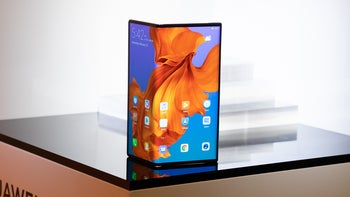Buying a foldable phone in 2019 will be an expensive mistake
This article may contain personal views and opinion from the author.

I get it – we're all ready and eager to move on to the next milestone in phone evolution, which at this point in time seems to be the foldable phone. We've been waiting patiently for this tech to become ready for mainstream introduction, and we've also gotten tired of the yearly iterative upgrades which all but defined the smartphone industry during the last few years. We crave the next big thing, and now that manufacturers such as Samsung and Huawei have given us a taste of it, the temptation to rush in this new direction can be felt in the air.
I hate to be that guy, but: don't, just don't buy a foldable phone this year.
Let me tell you why (I have many reasons)...
2019 foldable phones will be semi-experimental devices
We're seeing it already. Both Samsung and Huawei are planning on releasing their foldable phones by the middle of the year, but the devices are not yet in a state to be used by anyone. No one outside of Samsung and Huawei (and probably some corporate partners) has even touched these products, and the reason is they are not ready. There is still some time to polish them up before release, but most of the R&D and engineering legwork has already been done, so it's not very likely that there will be major changes in the hardware from now until release.
This isn't a very good sign for our early foldables. Here at the Mobile World Congress, we've been quick to notice that there's a visible bump (or wrinkle) in the Huawei Mate X's screen, right where it folds. We've also noticed this in the Samsung Galaxy Fold prototypes that are displayed here (only behind glass). It's very interesting to see if any company will be able to solve this problem, or if the Mate X and Galaxy Fold will be launched with some amount of this imperfection anyway.
The folding screens are obviously the most problematic components here, but the brand new hinges, which will for the first time ever allow you to fold your smartphone in two, are bound to cause problems, too. Fitting the hardware components inside the phones in such a way as to allow you to fold them, and then designing all that around a specialized hinge that would be responsible for holding the thing together and for enabling much of its functionality, will be as big an engineering feat as creating the bendable OLED screen itself. Much of the uptick in reliability and seamlessness of the user experience we've been enjoying with modern smartphones has been due to the fact that manufacturers have been able to reduce the number of moving parts to zero. Now, in the quest to fit as much screen as possible in as little space as possible, we're again adding a bunch of moving parts, and we know those things tend to be a weak link.
That's not to say that foldable phones won't have reliable hinges, but this being a brand new component type, the chances of running into problems (if not from the beginning, then maybe down the road) are pretty high.
Prices will be much, much lower a year from now
You've probably seen the price tags announced for the Galaxy Fold and Mate X: $1980 and EUR 2300 (around $2600), respectively. I'm sure Samsung and Huawei execs would love you to drop that kind of dough for their first attempts at this form-factor, but you're smarter than that.

The Huawei Mate X may launch at the astonishing price of about $2600.
All of that means that once these first baby steps are made, we're bound to see a whole host of manufacturers jump on the bandwagon and start contributing to the foldable device type. The multitude of makers from China will be especially instrumental in the quick propagation of the technology, and we all know how good those guys are at pushing costs down. Xiaomi, for example, has already started teasing its fans with a foldable phone prototype.
In a year from now, those $2000 beta-version foldables will be more like $1300 polished foldables (conservative estimation). Why would one jump the gun this year in a scenario such as this? Just hold your wallet shut and watch as early adopter enthusiasts struggle through the kinks of the first generation. What's more, if you're truly enthusiastic about foldable phones, you'll surely want to upgrade to the way more refined experience of next year's generation.
Think ahead to hefty repair costs
We don't know how durable these foldable phones are going to be, but chances are they'll be flimsier than our trusted flat phones. We're already paying astronomical amounts for broken OLED screens. Can you imagine the repair / replacement costs for a 7" flexible OLED panel?

When that massive wrap-around screen breaks, the repair bill may shock you.
In the case of the Samsung Galaxy Fold, at least it folds on the inside, so the main display will be more or less protected, though we can't know if it won't still crack if you drop your Fold on the ground. The Mate X's display, however? It folds on the outside, and it covers the whole phone – front to back. It'll be almost twice as easier to crack it than that of a normal phone today. And while your warranty will probably cover screen defects that might occur naturally with usage (hopefully there aren't such, but who knows how these first folding displays will hold up after a year), it certainly won't cover accidental drop damage. We're looking at repairs bills at least in the multiple hundreds. And no, there are no cases for foldable phones yet.
In a year, many of the inevitable hardships of living with a foldable phone should be figured out, like how to keep them safe, and how to avoid the possibility of $1000 repairs.
The software will have bugs, for sure
Most manufacturers have just recently become consistent in delivering stable and reliable software releases. That's for good old flat and rigid smartphones. Imagine the added complexity of a foldable phone – every piece of the whole system, including apps, will need to be updated and optimize for both closed and unfolded use.

First-gen models are quickest to get abandoned by their makers
This is a big one. It often happens when a company releases a product that is very new in its nature — the first-gen product in a particular new direction (like the first iPad or the first foldable phone) — that those products don't get supported for a very long time.
This happens for a number of reasons, most importantly because the underlying tech in first-gen products is often just good enough for release, and doesn't have much headroom to support future software releases designed to take advantage of the newer, rapidly developing components.

Remember the first-gen iPad? It was revolutionary, but got supported for just two years after release. The iPad 2, on the other hand, received timely updates for the amazing five years!
This is even true of some Apple first-gen products, like the original iPad. The original iPad was a groundbreaking device that was launched to immediate market success, but was actually supported for just two years after release. Initially launched with iOS 3, it was only updated up to iOS 5. In contrast, its successor, the also very successful iPad 2, continued to receive software update for the amazing five years! Thus, after being launched with iOS 4 in 2011, the iPad 2 lived to see an official update to iOS 9 in 2016! What a huge difference in support after just a year of product maturation.
And that's Apple we're talking about – imagine the kind of support these first-gen foldable phones are going to receive from companies like Huawei or Samsung.
The goal of this article isn't to bad-mouth foldable phones, but to save some people a lot of money. These first products are mighty expensive, but definitely not out of reach for a lot of people, so it makes sense to really consider whether a foldable phone would constitute a smart purchase this year. To me, the answer is definitely not. I can perfectly see the allure of devices like the Mate X – cool-looking, innovative, futuristic and powerful – the foldable form-factor really seems to be the next big step in the evolution of the smartphone. However, this is simply not the time to buy a foldable phone. You'll pay a lot of money for an incomplete, beta-version product. We've waited this long, let's give it another year, and we'll have a significantly wider range of better models to choose from, at considerably lower prices.










Things that are NOT allowed: